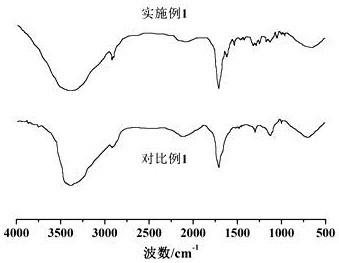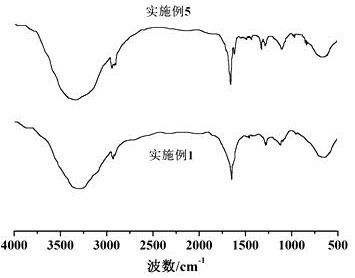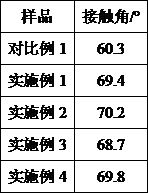Gradient-color organic silicon nano composite material as well as production process and application thereof
A composite material and organosiloxane technology, applied in anti-corrosion coatings, fire-retardant coatings, coatings, etc., can solve problems such as the inability to display the surface temperature of the product, the difficulty for workers to grasp the operation, and the peeling of the paint on the surface of the product, and achieve good temperature sensing. Discoloration ability, visual effect enhancement, acid and alkali corrosion resistance enhancement effect
- Summary
- Abstract
- Description
- Claims
- Application Information
AI Technical Summary
Problems solved by technology
Method used
Image
Examples
preparation example Construction
[0044] Preparation of reversible color pigments:
[0045] (1) Disperse vanadium pentoxide and lanthanum chromite in 0.8M oxalic acid aqueous solution according to the above weight parts, and stir and disperse at 55°C and 430rpm for 45min;
[0046] (2) Then the temperature of the system was lowered to 12°C, and the coupling agent (a mixture of equal amounts of acetylacetone and tetraisopropyl titanate) was added dropwise. After the addition was completed, the temperature was raised to 65°C at a rate of 2.5°C / min, and then Add nano silicon dioxide and niobium pentoxide, keep stirring for 2 hours;
[0047] (3) Then the system was heated to 118°C for 9 hours in vacuum, then calcined at 760°C for 4 hours in an air atmosphere, and finally crushed to nanoscale to obtain a reversible color-reversing pigment.
Embodiment 1
[0049] Preparation of organosiloxanes:
[0050] Mix chloromethyltriethoxysilane and triethylamine, slowly add 1-amino-N-(cyclopropylsulfonyl)-2-vinyl-cyclopropanecarboxamine hydrochloride dropwise, and complete the dropwise addition within 30 minutes , heated to 74°C and reacted for 6.5 hours, filtered by suction and purified by vacuum distillation to obtain organosiloxane (its chemical structure is shown below); the whole reaction process is protected by nitrogen and strictly waterproof; specifically, chloromethyltriethoxysilane , triethylamine and 1-amino-N-(cyclopropylsulfonyl)-2-vinyl-cyclopropanecarboxamine hydrochloride in a molar ratio of 1:1.1:1.05.
[0051]
[0052] 1 H NMR (400 MHz, DMSO-d6): 7.63 (s, 1H, N-H), 5.51 (m, 1H, CH=C), 5.13, 4.85 (m, 2H, C=CH 2 ), 3.94 (m, 6H, Si-O-CH 2 ), 2.05 (s, 1H, N-H), 1.90 (s, 2H, Si-CH 2 ), 1.84, 1.32 (2H, -CH), 1.29 (t, 9H, -CH 3 ), 0.58~0.95 (6H, -CH 2 ).
[0053] Preparation of modified polyacrylate emulsion:
[0054...
Embodiment 2
[0063] The preparation of organosiloxane is the same as in Example 1.
[0064] The difference between the preparation of the modified polyacrylate emulsion and Example 1 is that the molar ratio of hexafluorobutyl methacrylate, butyl acrylate, acrylic acid, organosiloxane, and ethyl silicate is 1:1.1:0.4:0.2 : 0.03; the addition of emulsifier is 2wt% of the total amount of monomers; the addition of initiator is 0.5wt% of the total amount of monomers.
[0065] The preparation of the leveling agent was the same as in Example 1.
[0066] The raw material composition of a gradient color composite material includes: by weight, 46 parts of modified polyacrylate emulsion, 18 parts of aluminum silicate, 9 parts of reversible color pigment, 2 parts of pigment additive, 16 parts of water, 1.5 parts of Sodium hydroxymethyl cellulose, 1 part of leveling agent, 1 part of OT-75, 0.8 part of water-based defoamer, 0.5 part of dispersant, 0.6 part of dodecyl alcohol ester. Among them, the pig...
PUM
| Property | Measurement | Unit |
|---|---|---|
| Particle size | aaaaa | aaaaa |
Abstract
Description
Claims
Application Information
 Login to View More
Login to View More - R&D
- Intellectual Property
- Life Sciences
- Materials
- Tech Scout
- Unparalleled Data Quality
- Higher Quality Content
- 60% Fewer Hallucinations
Browse by: Latest US Patents, China's latest patents, Technical Efficacy Thesaurus, Application Domain, Technology Topic, Popular Technical Reports.
© 2025 PatSnap. All rights reserved.Legal|Privacy policy|Modern Slavery Act Transparency Statement|Sitemap|About US| Contact US: help@patsnap.com



